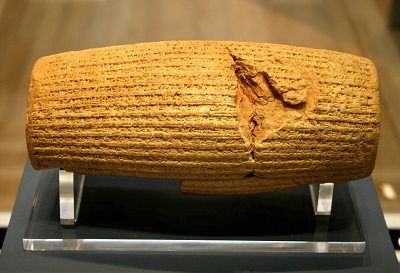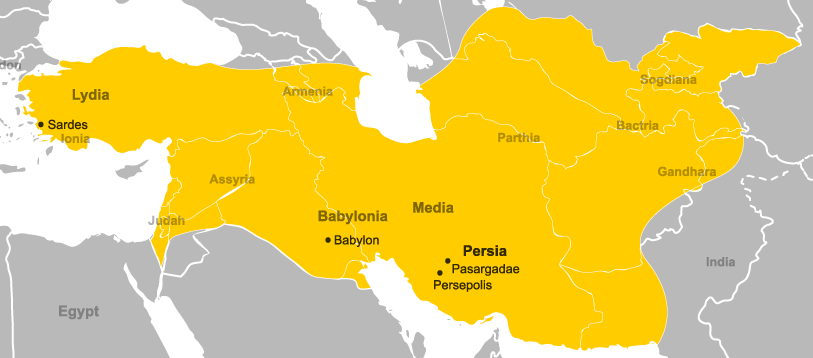That Cyrus was the first Persian conqueror, and that the space which he overran covered no less than fifty degrees of longitude, from the coast of Asia Minor to the Oxus and the Indus, are facts quite indisputable; but of the steps by which this was achieved, we know very little.
Continuing Cyrus Begins the Persian Empire,
our selection from A History of Greece by George Grote published in 1856. For works benefiting from the latest research see the “More information” section at the bottom of these pages. The selection is presented in seven easy 5 minute installments.
Previously in Cyrus Begins the Persian Empire.
Time: 600 – 530 BC
Place: Near East

CC BY-SA 4.0 image from Wikipedia.
To the historian of Halicarnassus we have to oppose Ctesias — the physician of the neighboring town of Cnidus — who contradicted Herodotus, not without strong terms of censure, on many points, and especially upon that which is the very foundation of the early narrative respecting Cyrus; for he affirmed that Cyrus was no way related to Astyages. However indignant we may be with Ctesias for the disparaging epithets which he presumed to apply to an historian whose work is to us inestimable — we must nevertheless admit that, as surgeon in actual attendance on king Artaxerxes Mnemon, and healer of the wound inflicted on that prince at Cunaxa by his brother Cyrus the younger, he had better opportunities even than Herodotus of conversing with sober-minded Persians, and that the discrepancies between the two statements are to be taken as a proof of the prevalence of discordant, yet equally accredited, stories. Herodotus himself was in fact compelled to choose one out of four. So rare and late a plant is historical authenticity.
That Cyrus was the first Persian conqueror, and that the space which he overran covered no less than fifty degrees of longitude, from the coast of Asia Minor to the Oxus and the Indus, are facts quite indisputable; but of the steps by which this was achieved, we know very little. The native Persians, whom he conducted to an empire so immense, were an aggregate of seven agricultural, and four nomadic tribes — all of them rude, hardy, and brave — dwelling in a mountainous region, clothed in skins, ignorant of wine, or fruit, or any of the commonest luxuries of life, and despising the very idea of purchase or sale. Their tribes were very unequal in point of dignity, probably also in respect to numbers and powers, among one another. First in estimation among them stood the Pasargadæ; and the first phratry or clan among the Pasargadæ were the Achaemenidae, to whom Cyrus himself belonged. Whether his relationship to the Median king whom he dethroned was a matter of fact, or a politic fiction, we cannot well determine. But Xenophon, in noticing the spacious deserted cities, Larissa and Mespila, which he saw in his march with the ten thousand Greeks on the eastern side of the Tigris, gives us to understand that the conquest of Media by the Persians was reported to him as having been an obstinate and protracted struggle. However this may be, the preponderance of the Persians was at last complete: though the Medes always continued to be the second nation in the empire, after the Persians, properly so called; and by early Greek writers the great enemy in the East is often called “the Mede” as well as “the Persian.” The Median Ekbatana too remained as one of the capital cities, and the usual summer residence, of the kings of Persia; Susa on the Choaspes, on the Kissian plain farther southward, and east of the Tigris, being their winter abode.
Continued below the map.

CC BY-SA 3.0 image from Ancient History Encyclopedia.
The vast space of country comprised between the Indus on the east, the Oxus and Caspian Sea to the north, the Persian Gulf and Indian Ocean to the south, and the line of Mount Zagros to the west, appears to have been occupied in these times by a great variety of different tribes and people, yet all or most of them belonging to the religion of Zoroaster, and speaking dialects of the Zend language. It was known amongst its inhabitants by the common name of Iran or Aria: it is, in its central parts at least, a high, cold plateau, totally destitute of wood, and scantily supplied with water; much of it indeed is a salt and sandy desert, unsusceptible of culture. Parts of it are eminently fertile, where water can be procured and irrigation applied. Scattered masses of tolerably dense population thus grew up; but continuity of cultivation is not practicable, and in ancient times, as at present, a large proportion of the population of Iran seems to have consisted of wandering or nomadic tribes with their tents and cattle. The rich pastures, and the freshness of the summer climate, in the region of mountain and valley near Ekbatana, are extolled by modern travellers, just as they attracted the Great King in ancient times during the hot months. The more southerly province called Persis proper (Faristan) consists also in part of mountain land interspersed with valley and plain, abundantly watered, and ample in pasture, sloping gradually down to low grounds on the sea-coast which are hot and dry: the care bestowed both by Medes and Persians on the breeding of their horses was remarkable. There were doubtless material differences between different parts of the population of this vast plateau of Iran. Yet it seems that, along with their common language and religion, they had also something of a common character, which contrasted with the Indian population east of the Indus, the Assyrians west of Mount Zagros, and the Massagetæ and other Nomads of the Caspian and the Sea of Aral — less brutish, restless and blood-thirsty than the latter — more fierce, contemptuous and extortionate, and less capable of sustained industry, than the two former. There can be little doubt, at the time of which we are now speaking, when the wealth and cultivation of Assyria were at their maximum, that Iran also was far better peopled than ever it has been since European observers have been able to survey it — especially the north-eastern portion, Bactria and Sogdiana — so that the invasions of the Nomads from Turkestan and Tartary, which have been so destructive at various intervals since the Mohammedan conquest, were before that period successfully kept back.
The general analogy among the population of Iran probably enabled the Persian conqueror with comparative ease to extend his empire to the east, after the conquest of Ekbatana, and to become the full heir of the Median kings. If we may believe Ctesias, even the distant province of Bactria had been before subject to those kings. At first it resisted Cyrus, but finding that he had become son-in-law of Astyages, as well as master of his person, it speedily acknowledged his authority.
| <—Previous | Master List | Next—> |
More information here and here, and below.
We want to take this site to the next level but we need money to do that. Please contribute directly by signing up at https://www.patreon.com/history
Leave a Reply
You must be logged in to post a comment.